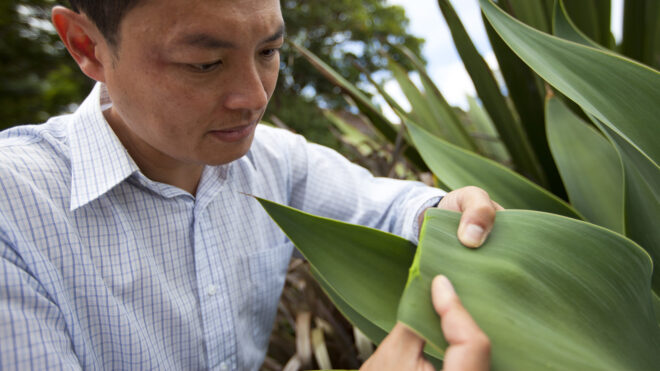The need for alternative green energy fuels is continually increasing as pressure mounts to cut greenhouse gas emissions and the demand rises. So what makes the agave plant more suitable for producing bioethanol than it’s maize corn and sugarcane alternatives?
With a low water requirement, the agave plant is able to grow in semi-arid conditions without irrigation. “Agave is an environmentally friendly crop that we can grow to produce ethanol-based fuels and healthcare products,” says Daniel Tan, associate professor at the Sydney Institute of Agriculture. “It’s heat and drought tolerant and can survive Australia’s hot summers.”

Prof. Tan believes agave has potential as a biofuel.
Bioethanol from agave offers advantages
According to Dr Xiaoyu Yan, senior lecturer in energy and environment at the University of Exeter, bioethanol derived from agave is superior to that from maize corn and sugarcane in terms of water consumption, quality, greenhouse gas emissions and ethanol output.
Working together, and alongside colleagues from the University of Adelaide, Prof Tan and Dr Yan conducted the first comprehensive lifecycle assessment and economic analysis of bioethanol produced from an agave field experiment in north Queensland. “Our analysis shows a bioethanol yield of 7,414l/ha per year is achievable with five-year-old agave plants.”
Though the study concluded that sugarcane yields more, at 9,900l/ha per year, its environmental impact through freshwater eutrophication (88%>), marine ecotoxicity (53%>) and water consumption (69%>) was higher than agave.

Agave grows in semi-arid conditions and is drought tolerant.
Agave grows even in dry soil
Maize corn yielded far less than agave, at 3,800l/ha per year, had 96% greater freshwater eutrophication, 59% higher marine ecotoxicity and 46% more water consumption.
“This shows agave is an economic and environmental winner for biofuel production in the years to come,” said Prof Tan.
“Agave is an economic and environmental winner for bioethanol production.”
Daniel Tan
Unfortunately, the economic analysis has suggested that the first generation of bioethanol production from agave is not currently commercially viable without government support, explains Prof Tan. “However, this may change with emerging demand for new ethanol-based healthcare products, such as hand sanitisers.”
Though the study exclusively looked at growing agave in Australia, a variety of the plant has been grown in parts of southern Europe since the mid-16th century, indicating there could be potential for it to be grown for bioethanol in other parts of the world in the future.
